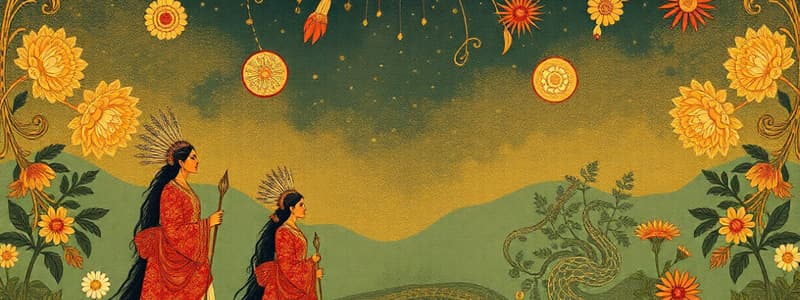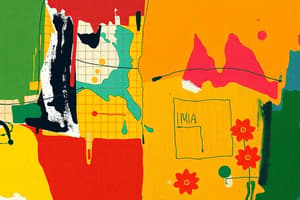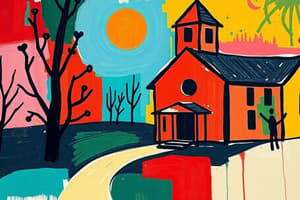Podcast
Questions and Answers
What time do the boys start working on the farm?
What time do the boys start working on the farm?
- One
- Twelve
- Six (correct)
- Nine
What activity do children engage in after dinner?
What activity do children engage in after dinner?
- Reading Scriptures (correct)
- Watching movies
- Manual employment
- Studying
Which of the following accurately describes the education schedule for children?
Which of the following accurately describes the education schedule for children?
- Children study in the morning and evening only.
- Boys receive education for a total of eight hours a day. (correct)
- Boys and girls attend different educational activities at the same time.
- Children study continuously without breaks.
What type of manual labor do children participate in after their schooling?
What type of manual labor do children participate in after their schooling?
What was the stated aim of the residential schools?
What was the stated aim of the residential schools?
At what age do children begin engaging in the educational programs?
At what age do children begin engaging in the educational programs?
Which activity do girls participate in during evening hours in the winter?
Which activity do girls participate in during evening hours in the winter?
What do the children do before going to bed?
What do the children do before going to bed?
What was the primary intention behind the Sixties Scoop child welfare policies?
What was the primary intention behind the Sixties Scoop child welfare policies?
What percentage of the child welfare population in Canada did Indigenous youth represent during the Sixties Scoop?
What percentage of the child welfare population in Canada did Indigenous youth represent during the Sixties Scoop?
What event led to the death of Anthony 'Dudley' George?
What event led to the death of Anthony 'Dudley' George?
In which year did the Canadian government officially return Stoney Point to Indigenous protestors?
In which year did the Canadian government officially return Stoney Point to Indigenous protestors?
What was the primary cause of conflict during the Oka Crisis?
What was the primary cause of conflict during the Oka Crisis?
Which of the following was a significant outcome of the Royal Commission on Aboriginal Peoples created in 1996?
Which of the following was a significant outcome of the Royal Commission on Aboriginal Peoples created in 1996?
What were the reported effects of the Sixties Scoop on Indigenous communities?
What were the reported effects of the Sixties Scoop on Indigenous communities?
During the Ipperwash Crisis, what was the Canadian government’s initial claim concerning Stoney Point?
During the Ipperwash Crisis, what was the Canadian government’s initial claim concerning Stoney Point?
What is one of the main focuses of the Royal Commission on Aboriginal Peoples (R.C.A.P)?
What is one of the main focuses of the Royal Commission on Aboriginal Peoples (R.C.A.P)?
Which category was NOT included in the inquiries made by the R.C.A.P?
Which category was NOT included in the inquiries made by the R.C.A.P?
What significant financial increase did the R.C.A.P recommend for Indigenous communities?
What significant financial increase did the R.C.A.P recommend for Indigenous communities?
What was one of the goals of the Truth and Reconciliation Commission (TRC)?
What was one of the goals of the Truth and Reconciliation Commission (TRC)?
Which of the following was NOT a task assigned to the Truth and Reconciliation Commission?
Which of the following was NOT a task assigned to the Truth and Reconciliation Commission?
Which statement best describes the overarching goal of R.C.A.P concerning Indigenous and settler relations?
Which statement best describes the overarching goal of R.C.A.P concerning Indigenous and settler relations?
What was one of the consequences identified in the Truth and Reconciliation Commission's report regarding the IRS system?
What was one of the consequences identified in the Truth and Reconciliation Commission's report regarding the IRS system?
The term 'self-determination' in the context of Indigenous rights refers to what?
The term 'self-determination' in the context of Indigenous rights refers to what?
What was one of the impacts of the Indian Act on Indigenous governance?
What was one of the impacts of the Indian Act on Indigenous governance?
Which ceremony was banned under the Indian Act in 1884?
Which ceremony was banned under the Indian Act in 1884?
What was the primary goal of the residential schools established in Canada?
What was the primary goal of the residential schools established in Canada?
How were Indigenous peoples affected by the legal definitions in the Indian Act?
How were Indigenous peoples affected by the legal definitions in the Indian Act?
Which aspect of the Indian Act demonstrated paternalism?
Which aspect of the Indian Act demonstrated paternalism?
What was one of the outcomes of the assimilation policies in Canada?
What was one of the outcomes of the assimilation policies in Canada?
Which of the following best describes the curriculum in residential schools?
Which of the following best describes the curriculum in residential schools?
What were the consequences of banning traditional ceremonies under the Indian Act?
What were the consequences of banning traditional ceremonies under the Indian Act?
Flashcards
Residential Schools
Residential Schools
A type of boarding school that existed in Canada from the late 19th century to the late 20th century. Their aim was to assimilate Indigenous children into Western culture by separating them from their families and communities, and by discouraging the use of Indigenous languages and traditions.
Assimilation
Assimilation
The intentional act of absorbing one culture into another, often involving the suppression of the original culture's traditions, language, and beliefs.
Legacy of Residential Schools
Legacy of Residential Schools
The lasting effects of Residential Schools on Indigenous individuals, families, and communities, which include intergenerational trauma, loss of language and culture, and the disruption of traditional social structures.
Cultural Suppression
Cultural Suppression
Signup and view all the flashcards
Intergenerational Trauma
Intergenerational Trauma
Signup and view all the flashcards
What is the Indian Act?
What is the Indian Act?
Signup and view all the flashcards
What was the goal of the Indian Act?
What was the goal of the Indian Act?
Signup and view all the flashcards
What is 'Status Indian'?
What is 'Status Indian'?
Signup and view all the flashcards
What is enfranchisement?
What is enfranchisement?
Signup and view all the flashcards
What were residential schools?
What were residential schools?
Signup and view all the flashcards
What did residential schools teach?
What did residential schools teach?
Signup and view all the flashcards
What was life like in residential schools?
What was life like in residential schools?
Signup and view all the flashcards
Who ran residential schools and what was their impact?
Who ran residential schools and what was their impact?
Signup and view all the flashcards
Sixties Scoop
Sixties Scoop
Signup and view all the flashcards
What was the Sixties Scoop?
What was the Sixties Scoop?
Signup and view all the flashcards
What were the impacts of the Sixties Scoop?
What were the impacts of the Sixties Scoop?
Signup and view all the flashcards
Ipperwash Crisis
Ipperwash Crisis
Signup and view all the flashcards
How did the Ipperwash Crisis begin?
How did the Ipperwash Crisis begin?
Signup and view all the flashcards
What happened during the Ipperwash Crisis?
What happened during the Ipperwash Crisis?
Signup and view all the flashcards
Oka Crisis
Oka Crisis
Signup and view all the flashcards
What happened during the Oka Crisis?
What happened during the Oka Crisis?
Signup and view all the flashcards
Royal Commission on Aboriginal Peoples (RCAP)
Royal Commission on Aboriginal Peoples (RCAP)
Signup and view all the flashcards
Truth and Reconciliation Commission (TRC)
Truth and Reconciliation Commission (TRC)
Signup and view all the flashcards
Indigenous Self-Determination
Indigenous Self-Determination
Signup and view all the flashcards
Reconciliation
Reconciliation
Signup and view all the flashcards
Restructuring Relations
Restructuring Relations
Signup and view all the flashcards
Independent Court for Land Claims
Independent Court for Land Claims
Signup and view all the flashcards
Aboriginal University
Aboriginal University
Signup and view all the flashcards
Increased Funding for Indigenous Communities
Increased Funding for Indigenous Communities
Signup and view all the flashcards
Study Notes
Impacts of Colonization in Canada (Social 30)
- The Indian Act (1876) gave the Canadian government responsibility over Indigenous peoples and their land, a form of paternalism.
- It introduced Indian Agents to enforce government will and gave the Canadian government legal control of Indigenous resources.
- Indigenous bands were allotted very little power.
- The Canadian government legally dictated social institutions like status, assembly, marriage, and education for Indigenous peoples.
Changes Under the Indian Act
- Band leaders were elected, replacing hereditary positions.
- The Potlatch Ceremony was banned in 1884.
- All traditional ceremonies were banned in 1895.
- Indigenous people were prohibited from accessing lawyers without government consent for land claim concerns (1927).
- "Indian Status" was rigidly defined, primarily excluding Métis and Inuit initially and later including those of "full blood" or belonging to a band.
- Status Indians had access to government programs.
- Enfranchisement eliminated status.
- Social institutions, such as marriage, were significantly more restrictive for women.
The Push for Assimilation
- Assimilation is a process where individuals or groups of differing ethnic heritage are absorbed into the dominant culture of a society. This was a goal of the Canadian government toward Indigenous peoples
Residential Schools
- Residential schools were aimed at "killing the Indian, and saving the child."
- They were run cooperatively by the Canadian government and the Catholic Church.
- Children were separated from their families, communities, and cultural practices.
- Indigenous languages, clothing, and spiritual practices were banned.
- Curriculum focused primarily on language, reading, religion, and ethics, with a very tight schedule often focused on practical labor rather than academic concerns.
- The schools often involved psychological, physical and sexual abuse.
- Learning about indigenous cultures took a back seat to training students for assimilation into the dominant culture.
Residential Schools (Specifics)
- Daily schedules, from 5 AM wake-up calls to evening studies focused on the Bible and practical skills, were rigidly enforced.
- Students' daily life was highly regimented, including structured learning, labor, recreation, and worship.
Sixties Scoop
- A series of child welfare policies from the mid-1950s to the mid-1980s aimed at removing Indigenous children from their homes.
- Indigenous children were placed in foster homes and residential schools by welfare agencies.
- In 1977, around 15,500 Indigenous children were under the care of child welfare authorities.
- Indigenous youth comprised over 20% of the population in welfare care, yet represented less than 5% of the total youth population in Canada.
- The Sixties Scoop resulted in generational trauma, harming family structures, social values, and economic conditions.
- High rates of suicide, violence, depression, substance abuse, and alcoholism exist in some Indigenous communities, directly connected to the trauma of this period.
Ipperwash Crisis
- The Canadian government claimed Stoney Point, Ontario, as a military camp.
- They attempted to seize Indigenous lands for military use.
- Indigenous protestors occupied Stoney Point, demanding recognition of their rights and the return of stolen land.
- A police officer was killed during these protests.
- Extensive negotiations followed.
- The returned land was eventually returned. However, the process took decades of legal battle, and Indigenous families, community and cultural heritage groups were negatively impacted.
Oka Crisis
- This crisis involved disputed territory in Kanesatake, Quebec.
- Indigenous peoples protested the expansion of a golf course on their land
- Protests escalated, culminating in violence and a large military response.
- Negotiated resolution included the halt to land development and a purchase of the disputed lands.
Royal Commission on Aboriginal Peoples (RCAP)
- Created in 1996 in response to the Oka Crisis.
- The commission involved both Indigenous and non-Indigenous members.
- Focused on Indigenous self-governance and compensation for past injustices.
- Included inquiries with many different Indigenous people about governance, land, economy, social, and cultural issues.
- Specifically focused on historical, urban, women's, and children's perspectives.
RCAP Recommendations
- Complete restructuring of relations between settlers and Indigenous peoples.
- Indigenous right to self-determination, including an independent court to settle land claims.
- Increased funding for Indigenous communities in health, housing, education, employment, and creation of an Aboriginal university.
Truth and Reconciliation Commission (TRC)
- Established in 2008.
- Acknowledged residential school experiences, impacts and consequences.
- Provided culturally appropriate ways to support former students, families, and communities.
- Promoted awareness, support, and truth and reconciliation events.
- Created an accessible historical record of the residential schools system, outlining its operation, purpose, and impact.
- Provided recommendations to the Canadian government on the lasting legacy of residential schools, and the ongoing impact on Indigenous individuals.
Studying That Suits You
Use AI to generate personalized quizzes and flashcards to suit your learning preferences.



